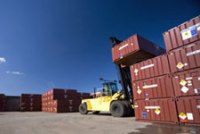A consultation has been launched on a new strategy for the management of the UK's solid low-level radioactive waste. The strategy seeks to prevent, reduce, reuse and recycling as much material as possible.
 |
Emplacing LLW at Drigg (Image: NDA) |
According to the strategic review document, some 44% of the LLW and 69% of the high-volume very low-level waste (VLLW) to be generated in the UK will originate from the Sellafield site. Contaminated metal accounts for 37% of LLW, while soil and rubble accounts for 33%. Of the VLLW, some 63% is soil and rubble and 23% is metal.
According to the NDA, LLW makes up about 90% of the UK's total radioactive waste, but contains less than 0.0003% of the total radioactivity. Most of the LLW in the UK is disposed of in the Drigg low level waste repository (LLWR) in Cumbria, with little or no pre-treatment. Some 25,000 cubic metres (m3) of LLW are expected to be generated in the UK annually.
The Drigg facility is nearing capacity, but more space is being built and there are plans for expansion in the future. However, the NDA says that even with this extra capacity (potentially 700,000 m3 subject to planning and regulatory approvals), there will still be a "significant shortfall" compared with the amount of waste forecast to be generated over the long term (3 million m3 over 120 years).
An analysis of the LLW inventory shows that "continuation of past approaches to LLW management will result in around 2.4 million m3 of LLW requiring disposal at LLWR or a new national LLW repository."
"Without a different approach to the management of LLW a new repository could be required by 2037, or possibly even earlier. Consequently, past approaches to operating LLWR and management of UK LLW is no longer sustainable," the NDA said.
The proposed strategy, the NDA said, "will provide continued capability and capacity for the safe, secure and environmentally responsible management and disposal of LLW in the UK, for both the nuclear and non-nuclear industries." This would be achieved by: application of the waste management hierarchy; best use of existing facilities; and, development and use of new fit for purpose management and disposal routes.
The NDA said that the draft strategy looks at ways of "potentially reducing the amount of waste going to LLWR through the principles of preventing, reducing, reusing and recycling in order to make best use of the available national disposal capacity at the LLWR and reduce the need for an additional national facility in the future." This, it said "includes making the most of opportunities to reuse soil and rubble from the nuclear industry and clean and recycle metallic wastes that can be used elsewhere."
The proposed strategy does not cover liquid and gaseous LLW. The NDA said that it will continue to develop its strategic position on these wastes and this will be published in the next version of the NDA Strategy.
The solid LLW strategy is being launched along with the Strategic Environmental Assessment (SEA), which underpins the strategy. As part of the SEA, the NDA has also published the Environmental and Sustainability Report, which summarises the development of the nuclear industry LLW strategy, including consideration of reasonable alternatives, and presents the findings of the detailed assessment of the preferred options against a range of social, economic and environmental objectives.
The next step for development and implementation of the UK nuclear industry LLW strategy is a formal public consultation of the draft strategy and SEA between May and August 2009. The strategy will then be updated and recommended to government for approval in early 2010.
Jo Fisher, head of low level waste for the NDA, said: "Reduce, Reuse and Recycle is a familiar mantra for most homes now - and through the launch of this consultation we are looking at how we can apply these basic waste management principles to solid low level radioactive waste in a safe and sustainable manner."
She added, "We have listened to the views of the Low Level Waste Strategy Group and other stakeholders throughout - but are now keen to get feedback from a wider audience."
"There is no doubt that space for disposing of low level waste is at a premium. All of the comments received will help us to refine the strategy and develop the best possible solution for effectively managing the UK's solid low level radioactive waste now and for the future," Fisher said.




_23621.jpg)

_63865.jpg)
_18570.jpg)





